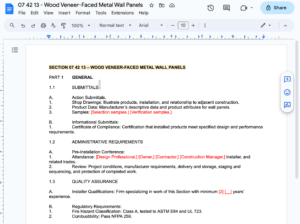Why are 3-part specifications so wordy?
If you’ve ever found yourself poring over lengthy 20+ page 3-part specifications for construction projects, you’re not alone. These documents often seem packed with words, seemingly going on forever. But here’s the catch: Do all those words actually make the specifications easier to work with? More enforceable, perhaps? Why are 3-part specifications so wordy?
In most cases, the answer is a resounding no. In this expert guide, we’ll dive into the reasons behind the length 3-part specifications and explore strategies to simplify them for better efficiency and clarity.
1. Master Specification Systems: A Culprit in Verbose Specs
First things first, it’s essential to understand that the verbosity of 3-part specifications can be attributed to the master specification system employed by architectural firms. Each office master specification system follows a proforma (page layout), which often results in consistent wording and copyright-protected content. Terms like “basis of design” and “the contractor shall, in strict accordance” are sprinkled throughout these documents, contributing to their extensive length.
When you come across a 20+ page section on something as seemingly straightforward as paint, it’s worthwhile to check for a copyright notice—it’s likely the reason behind the excessive verbiage.
2. Learning from Past Mistakes: The Influence of Troubled Projects
If you’ve encountered phrases like “Contractor shall strictly follow the installation instructions, meet warranty requirements, and follow job site conditions“ repeatedly in a specification, it’s a clear sign that the design professional has experienced their fair share of project mishaps. The quest to avoid past errors and the fear of litigation often lead to an overabundance of words in specifications.
But here’s the truth: No amount of verbiage can protect against every possible mistake a contractor might make. These verbose statements are considered “👻 gotchas,” serving little more than creating confusion and complexity. Instead of specifying construction means and methods, it’s more effective to outline clear expectations for the final product, allowing manufacturers and certified installers to handle the intricacies.
3. Legacy Specifying: Breaking Habits
The construction industry is steeped in tradition and habit, and specification text is no exception. Sections like “Section Includes,” “Reference Standards,” “Related Sections,” “Sustainability Credits,” and “Installation Instructions” have become customary in specifications. However, some of these inclusions add unnecessary length and complexity.
Section Includes: While intended to provide clarity, this redundancy can be avoided by relying on the section number and title to define content.
Related Sections: Though helpful in theory, keeping these sections updated can be a cumbersome task, often leading to added length and potential disputes.
Reference Standards: In the digital age, access to reference standards is just a click away, rendering lengthy lists of standards obsolete.
Sustainability Credits: As sustainability gains prominence, it’s time to rethink how we specify sustainability systems. Instead of lengthy descriptions, specifying the system itself can suffice.
Installation Instructions: With manufacturers providing comprehensive installation resources, specifying every detail is redundant. Focus on referencing manufacturer instructions and utilizing certified installers.
Conclusion: The Power of Simplified Specifications
Shorter, concise specifications are not just easier to work with; they also reduce the likelihood of litigation. Rather than telling contractors how to do their job, specify your expectations for the final product. By doing so, contractors gain clarity on what to estimate, what to expect, and how to correctly install the product.
This clarity ultimately leads to smoother projects with fewer disputes and, most importantly, a successful final outcome. Streamlining your specifications isn’t just about saving words; it’s about saving time, money, and headaches for all parties involved in construction projects.
Why are 3-part specifications so wordy? Sometimes it’s a project requirement, but often it’s a habit.



